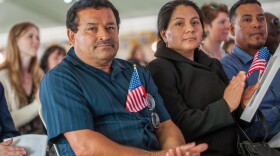After more than 80 years in the park in Dallas that bears his name, the city has removed a statue of Confederate Gen. Robert E. Lee. A city task force will consider the future of other Confederate monuments, but commentator William Holston believes that's not enough to right past wrongs.
There I was standing beneath a huge bronze statue of Confederate Gen. Robert E. Lee at a public protest addressing the blight of white supremacy on our city. I never could have imagined I would do that when I was a boy in Alabama, enthralled with the accounts of Confederate generals I devoured in history books.
I was raised immersed in the Myth of the Lost Cause. The leaders of the Confederate army were dashing cavaliers, underdogs fighting a Yankee invader. Slavery as a cause or issue in the war was rarely even mentioned. As I grew up, I began to read more beyond our school history books. Over time, I understood that these men fought to maintain the enslavement of others.
There's been a lot of debate around this statue of Robert E. Lee. Some folks thought it celebrated their heritage as Southerners. Others thought it was better to provide additional signage pointing out these statues were typically erected during the Jim Crow era and are intended to perpetuate myths about the Civil War.
After the events in Charlottesville, Virginia, I was moved to action.
I added my voice to those calling for the removal of the statues. When I saw the images of neo-Nazis and avowed white supremacists gathered around these monuments to the Confederacy, I realized that these were still potent symbols of and for white supremacy. I was grieved by the impact this had on my friends who are African-American and decided that those violent demonstrations require a dramatic response. I personally needed to take a stand and call for the removal from places of honor for these homages to Confederate heroes.
I also attended an interfaith conference put on by the local organization Faith in Texas to create a plan to confront white supremacy here in Dallas. The room was filled with Muslims, African-American Christians, rabbis, evangelicals, Methodists, Hispanic pastors and organizers and even old white men like me — a diverse group reaching across the categories of race, religion, gender and class to advocate for justice and equity. A formerly incarcerated man talked about minimum sentencing guidelines and mass incarceration. A rabbi spoke up for immigrants. A tear-filled DACA recipient talked about her fears connected to a repeal of this program. And a pastor talked about detained immigrants and their need for access to legal counsel.
These are the issues we need to talk about. The removal of that statue is just a beginning. Because our community is not defined by what we tear down, but by what we build in its place.
William Holston is Executive Director of the Human Rights Initiative of North Texas.






